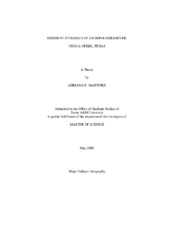| dc.description.abstract | Dams have altered flow distributions in rivers everywhere, causing a host of
changes in channel morphology and sediment dynamics. Although major changes in
flow regime have occurred along Yegua Creek, Texas, since the closure of Somerville
Dam in 1967, the issue of sediment transport has not been studied in detail. The extent
to which sediment is moving through the system remains unclear. This study addresses
the extent to which sediment is moving through and downstream of the dam. Analysis
of sediment samples collected at 23 sites in the Yegua Creek channel system showed
that coarse sand to silt-sized materials dominate the creek upstream of the dam, whereas
finer silt and clay sediments characterize the downstream portions. Calculation of the
trapping efficiency of the dam indicates that approximately 99.8% of materials from the
upper watershed are trapped behind Somerville Dam. Investigations of sediment
mobility further suggest that present flows are capable of mobilizing sediments
downstream of the dam. Although a de-coupling between the upper and lower portions
of the Yegua Creek watershed has likely occurred due to the high rate of sediment
trapping, new sediment sources that include tributaries and alluvial storage likely play a
larger role in providing materials for sediment transport downstream. Despite a reuction in peak flows, the channel morphology of Yegua Creek has apparently adjusted over the
four decades since construction of Somerville Dam to achieve a new equilibrium
characterized by sediment movement. These results are corroborated by analysis of
aerial photographs.
These findings augment our understanding of the many facets of the response of
fluvial systems to the disturbance posed by dam construction. Because Yegua Creek is a
major tributary to the Brazos River draining to the Texas coast, increased understanding
of sediment dynamics within Yegua Creek provides critical insights into the efficacy of
sediment delivery in a regional context, and ultimately to the Texas coastline. The
findings of this study also provide useful information for managing stream ecosystems
affected by impoundments. | en |


